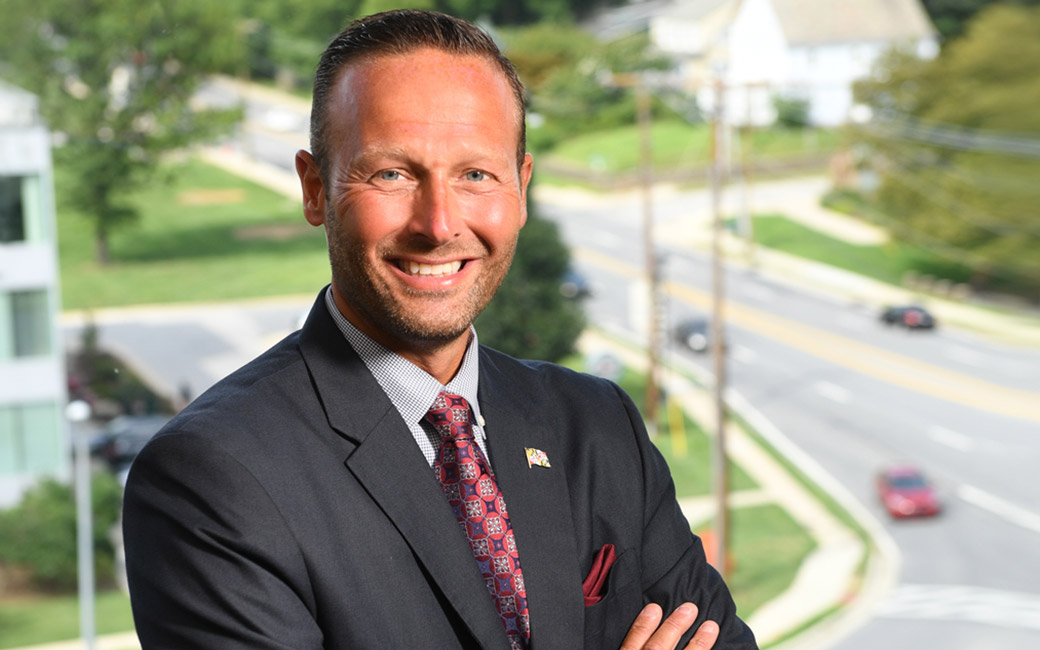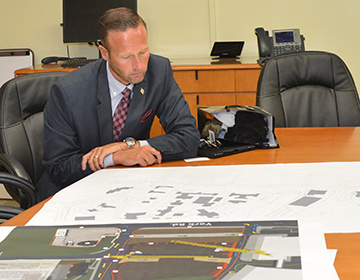Road Warrior
TU alumnus Greg Slater '97 keeps Marylanders moving.
By Ginny Cook on July 10, 2018

Stuck in traffic? Stalled by road construction? Stymied by snowstorms?
Greg Slater ’97 feels your pain. As administrator of Maryland’s Department of Transportation State Highway Administration (MDOT SHA), he understands the frustration of commuters and is committed to addressing traffic woes and keeping folks and vehicles on the move.
This road warrior battles antiquated systems that govern state transportation and fights the entrenched impression of the civil servant who is anything but civil or obliging.
Whether it’s clearing snow-covered roads, maintaining bridges, designing highway improvements, protecting the environment or something as simple as responding to phone or email complaints, Slater says the highway administration has to “rethink the way to do business.”
“Transportation is a quality-of-life issue. My job is to enhance the system for our entire state … and getting there can be painful,” he admits.
“ I want everybody out there working to make things better for the commuter. ”
His challenges include managing safety and infrastructure changes while modernizing an organization that he says, “from a policy perspective hasn’t changed in decades.”
Slater and the SHA are already doing more than lending bureaucratic lip service to problems. Streamlining freight-hauling permits at Baltimore’s port, instituting e-bidding and e-construction processes, protecting wildlife and the environment, and balancing construction costs with expediency are just some of the SHA’s recent innovations.
Time Is Money
It might seem like heresy for a state institution, but Slater’s agency doesn’t always award highway construction contracts to the lowest bidder. He wants bids that “provide the best price and value in the shortest amount of time,” he says.
When selecting speed over lowest price, Slater knows he must still be a steward of state tax dollars. But he also factors in costs to drivers — his customers — in detours, delays and frustration from road construction projects that can sometimes go on for years. He points to recent projects, including work on MD 32 that beat its completion date by a year, and I-270, an estimated four-year project that took 2 1/2 years.
Anyone who drove to the beach via MD 404 this summer can testify to the gridlock along the route. But the road construction will be complete by November, about one year after work began, another example of an accelerated construction contract. “I can’t wait to pay that last installment,” Slater says, noting that vacation travelers were inconvenienced for only one season.
What drivers may not notice is the SHA’s commitment to protecting wildlife. “We work to understand the habitats of various species,” Slater says.

Mussels in a stream at Rocks State Park in Harford County were relocated during a construction project and then reintroduced to their former home when it was safe to return. Special fencing prevents deer and other animals from crossing major highways while some culverts and bridges are designed for their safe passage. SHA also brought in the expertise of researchers in TU’s biology department to study the effectiveness of the relocation of 900 turtles from a highway construction area.
Baltimore’s port is also benefiting from a time-saving process developed by SHA in cooperation with a number of other state agencies. It used to take days or weeks to receive a freight-hauling permit to move goods out of the Port of Baltimore, Slater says. Now with a simplified, automated process, permits can sometimes be secured in hours, giving a boost to port business and Maryland’s economy. “Freight that would have come to surrounding ports now comes to Baltimore,” Slater explains.
An automated bid process and electronic management of construction activities are two other innovations that Slater says “are bringing out a broader, more competitive environment” to SHA’s operations.
The Road He Traveled
Slater started out at TU as a business major, but soon switched to geography and environmental planning, a choice that would eventually propel him to leadership in
Maryland’s transportation departments.
His background is dichotomous — an analytical side from his father, an engineer, and a creative side from his mother, an artist. (Both parents are TU graduates.)
“Early on I thought differently from everyone else,” he explains. “I came at things from a different angle.” But it was always systems — how they operated and how they can be improved — that fascinated him.
Two geography classes would build on that appeal, he adds. The first with Professor John “Jay” Morgan combined mapping and technology. Another examined how railroad networks shaped the country’s development.
After graduation, Slater spent his first two years in private industry before spending the next 18 with MDOT SHA. He most recently served as deputy administrator for planning, engineering, real estate and environment with seven years prior to that as planning director.

As SHA’s head, Slater manages an annual budget of $2 billion and oversees nearly 3,000 employees at its Baltimore headquarters, a complex in Hanover, more than two dozen maintenance shops and seven districts throughout the state.
“Greg Slater is an innovator, who brings great energy and new solutions to the table that meet the changing dynamics in the transportation world,” Gov. Larry Hogan said in a press release announcing his appointment.
Slater’s first day on the job, March 13, began in sunny Annapolis. One moment he was receiving congratulatory handshakes; the next he was thrown into crisis mode, managing a snow emergency as a blizzard tracked up the East Coast.
Someone handed him a yellow operations coat with his name scrawled on duct tape. During the next 27 hours, he hunkered down in an operations center to monitor pavement temperatures or drove around in an SUV to get firsthand information. Most of all, he wanted to make sure “those who really do the work,” he says, got the sleep and food they needed.
“I was fortunate that the director of maintenance had 35 years of experience,” Slater explains. “I could be helpful but also got out of the way.”
Slater on Leadership
In this 2-minute video produced by the Maryland Department of Transportation, Greg Slater talks about his vision for the State Highway Administration and the important of creating an environment where innovation can thrive. (Sept. 22, 2017)
Road Signs
Slater knows there are few long, lonesome highways in the state. Motorists in Maryland traveled some 58 billion miles last year, he says.
They drove over 2,567 bridges, of which only 67 need repair. That 67 is a number he’s proud of, noting Maryland has one of the lowest numbers of bridges that require work of any state in the country.
When an eight-lane bridge over the Mississippi River in Minnesota collapsed 10 years ago, “It changed the conversation about bridge safety,” Slater says. In Maryland, regular inspections and engineering analysis, along with timely overhauls, have kept the state’s bridges safe and off his list of things to worry about.
What does keep him up at night is the number of deaths on Maryland’s roads. Slater is notified whenever there is a fatality — grim statistics he can cite from memory. Last year 523 people died in traffic accidents, 20 percent of them pedestrians and six in road construction work zones.
He wishes he could do more to enhance safety and urges drivers to slow down, reminding them that “every person who died is someone’s loved one.”
All Roads Lead to Service
Slater’s compassion and drive come from an ingrained commitment to serve. When faced with tough decisions, he even refers to a list of attributes he keeps on a tablet. Among them are integrity, trust, dedication and dependability.
These guide his vision of an organization that delivers service to its customers. In fact, he invokes Nordstrom, the department store, as the customer service model he wants to emulate.
“People’s expectations are higher than ever,” Slater says. “The nature of what we do is that everybody’s an expert. Everybody drives; everybody walks. There are a lot of amateur engineers and amateur planners out there.
“Whether it’s a call or a [message] on Facebook or Twitter, they want to understand what we are doing. They are very personal, very direct.
“When they are stuck in traffic, it’s my fault. A pothole is my fault.”
Slater is willing to shoulder the blame. He’s been known to pick up the phone, listen and respond to commuters’ complaints.
“Everybody has something that is important to them and it’s important that we show that what’s important to them is important to us,” he says. It’s one way of meeting future transportation needs. He says, “It’s how we can make getting to work easier for you.”
This story is one of several related to President Kim Schatzel's priorities for Towson University: TU Matters to Maryland.